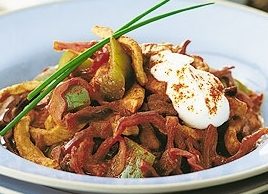Quick Hungarian Goulash
This quick version of classic Hungarian goulash is rich and delicious. Strips of lean pork, shredded red cabbage and green pepper cook quickly and taste excellent with the traditional flavourings of paprika and caraway seeds.
Source: Cook Smart for a Healthy Heart, Reader’s Digest Canada

| Servings | Prep Time | Cook Time |
| 4servings | 10minutes | 25minutes |
| Servings | Prep Time |
| 4servings | 10minutes |
| Cook Time |
| 25minutes |
- 2 tbsp extra virgin olive oil
- 1 large onion finely chopped
- 2 garlic cloves crushed
- 300 g thick lean pork loin steaks cut into thin strips
- 1 tbsp all-purpose flour
- 3/4 cup reduced-salt chicken stock
- 1/2 cup dry white vermouth
- 2 tbsp paprika
- 1 tsp caraway seeds
- 1 tsp caster (superfine) sugar
- 1 796ml can tomatoes drained
- 1 large green pepper seeded and chopped
- 200 g red cabbage finely shredded
- pepper to taste
- 4 tbsp Greek-style yogurt to serve
- paprika to serve
- fresh chives to serve
|
Ingredients
Servings: servings
Units:
|
- Heat the oil in a large frying pan or saucepan. Add the onion, garlic and pork, and cook over high heat for about 3 minutes or until the meat has changed colour and become firm and the onion is slightly softened. Meanwhile, blend the flour with 5 tablespoons of the chicken stock to make a smooth paste; set aside.
- Add the vermouth, paprika, caraway seeds and sugar to the pan and stir, then add the tomatoes, breaking them up as you mix them in. Stir in the remaining stock, and the flour and stock mixture. Bring to a boil, stirring, and cook until the juices thicken.
- Stir in the pepper and red cabbage until both are thoroughly coated in the cooking juices. Reduce the heat, cover the pan and simmer for about 15 minutes or until the meat is cooked and the vegetables are just tender, but still slightly crisp.
- Taste the Hungarian goulash and season with pepper. Ladle into bowls and top each portion with a spoonful of Greek-style yogurt and a sprinkling of paprika. Garnish with chives and serve.
Per serving: 319 calories, 21 g protein, 15 g total fat, 4 g saturated fat, 50 mg cholesterol, 18 g total carbohydrate, 14 g sugars, 6 g fibre, 195 mg sodium
Studies have shown that eating garlic can reduce the risk of heart attack and stroke by making the blood less sticky and likely to clot. Garlic can also help to reduce high blood pressure.




